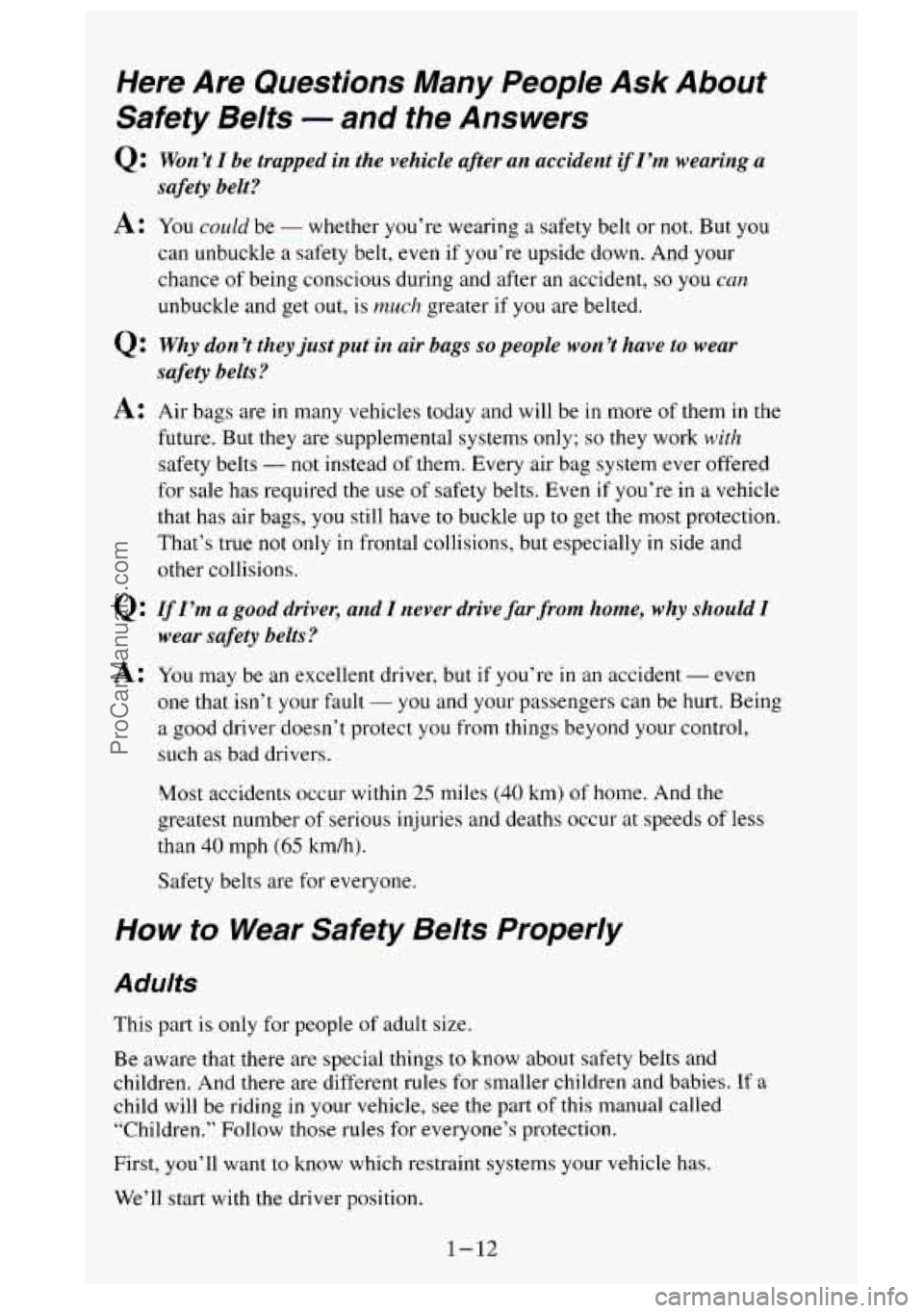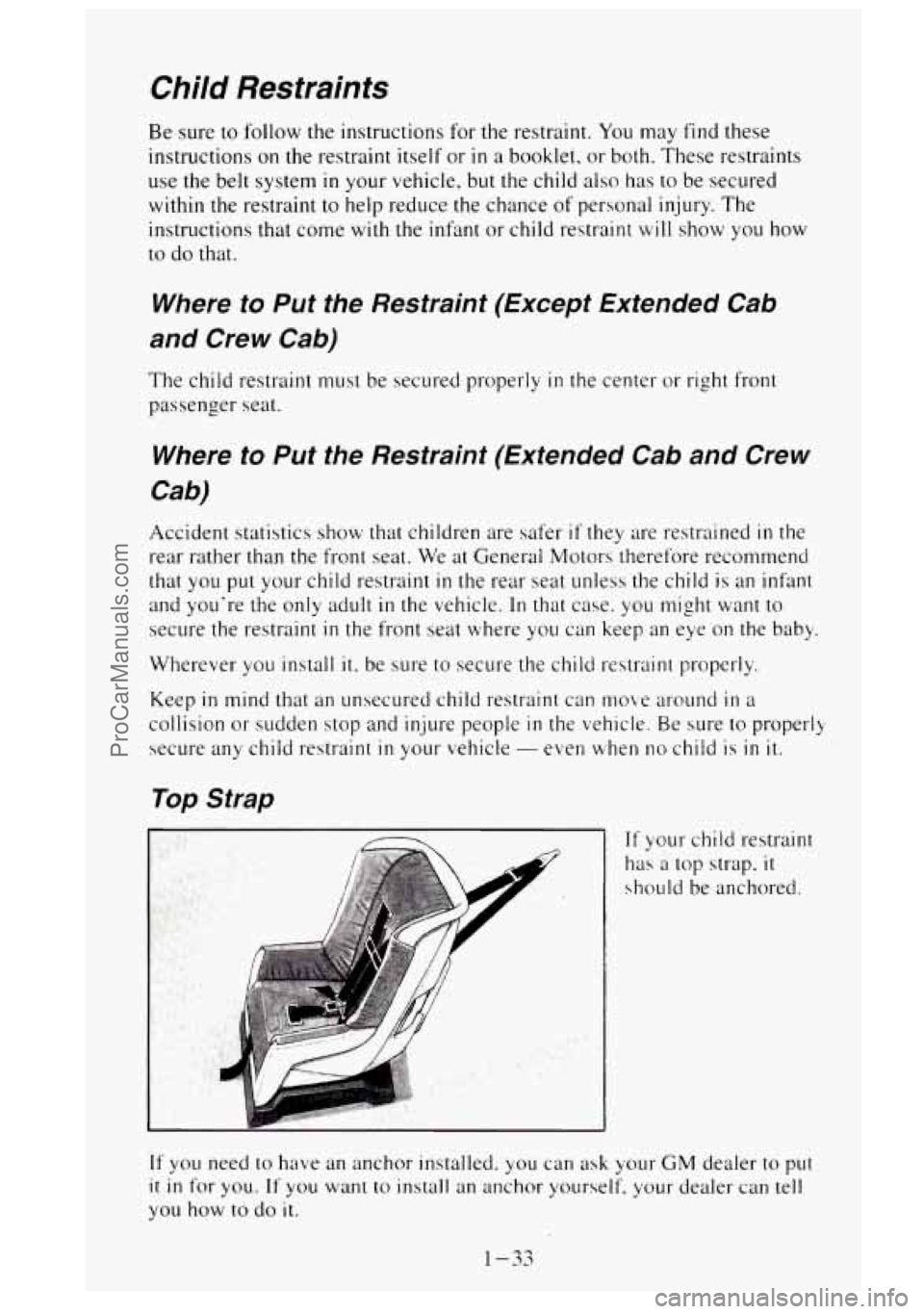Page 4 of 488
As of September 1, 1995, this information replaces Step 7 of the
“Securing a Child Restraint in a Center Seat Position” portion of your
owner’s manual
on the following pages, depending on your vehicle:
CIK Series, Sierra: 1-39
Suburban, Tahoe and Yukon: 1-45
Rally, Vandura and Chevy Van: 1-36
Astro and Safari: 1-37
Lumina and Trans Sport: 1-56
7. Push and pull the child restraint in different directions to be sure it
is secure. If it isn’t, secure the restraint in a different place in the
vehicle and contact
the child restraint maker for their advice about
how
to attach the child restraint properly.
2
ProCarManuals.com
Page 28 of 488

Here Are Questions Many People Ask About
Safety Belts
- and the Answers
Q:
A:
Q:
A:
Q:
A:
Won ’t I be trapped in the vehicle after an accident if I’m wearing a
safety belt?
You could be - whether you’re wearing a safety belt or not. But you
can unbuckle
a safety belt, even if you’re upside down. And your
chance of being conscious during and after an accident,
so you can
unbuckle and get out, is much greater if you are belted.
Why don’t they just put in air bags so people won’t have to wear
safety belts?
Air bags are in many vehicles today and will be in more of them in the
future. But they are supplemental systems only;
so they work with
safety belts - not instead of them. Every air bag system ever offered
for sale has required the use of safety belts. Even
if you’re in a vehicle
that has air bags, you still have
to buckle up to get the most protection.
That’s true not only in frontal collisions, but especially
in side and
other collisions.
If I’m a good drive4 and I never drive far from home, why should I
wear safety belts?
You may be an excellent driver, but if you’re in an accident - even
one that isn’t your fault
- you and your passengers can be hurt. Being
a good driver doesn’t protect you from things beyond your control,
such
as bad drivers.
Most accidents occur within
25 miles (40 km) of home. And the
greatest number of serious injuries and deaths occur at speeds
of less
than
40 mph (65 km/h).
Safety belts are for everyone.
How to Wear Safety Belts Properly
Adults
This part is only for people of adult size.
Be aware that there are special things to know about safety belts and
children. And there are different rules for smaller children and
babies. If a
child will be riding in your vehicle, see the part of this manual called
“Children.” Follow those rules for everyone’s protection.
First, you’ll want to know which restraint systems your vehicle has.
We’ll start with the driver position.
1-12
ProCarManuals.com
Page 47 of 488
Everyone in a vehicle needs protection! That includes infants and dl
children smaller than adult size. In fact, the law in every state in the United
States and
in every Canadian province says children up to some age must be
restrained while
in a vehicle.
Smaller Children and Babies
A CAUTION:
Smaller children and babies should always be restrained in a
child or infant restraint. The instructions for the restraint will
say whether it is the right type and size for your child. A very
young child’s hip bones are
so small that a regular belt might
not
stay low on the hips, as it should. Instead, the belt will likely
be over the child’s abdomen. In a crash the belt would apply
force right on the child’s abdomen, which could cause serious or
fatal injuries.
So, be sure that any child small enough for one is
always properly restrained in a child or infant restraint.
1-31
ProCarManuals.com
Page 49 of 488

Child Restraints
Be sure to follow the instructions for the restraint. You may find these
instructions
on the restraint itself or in a booklet. or both. These restraints
use the belt system in your vehicle. but the child also has to be secured
within the restraint
to help reduce the chance of personal injury. The
instructions that come with the.
inhnt or child restraint will show you how
to do that.
Where to Put the Restraint (Except Extended Cab
and Crew Cab)
The child restraint must be secured properly in the center or right front
passenger seat.
Where to Put the Restraint (Extended Cab and Crew
Cab)
Accident statistics show that children are safer if they are restrained in the
rear rather than the front seat. We at General Motors therefore recommend
that
you put your child restraint in the rear seat unless the child is an infant
and you’re the only adult
in the vehicle. In that case. you night want to
secure the restraint
in the front seat where you can keep an eye on the baby.
Wherever you install
it, be sure to secure the child restraint properly.
Keep
in mind that an unsecured child restraint can move around in a
collision or sudden stop and injure people
in the vehicle. Be sure to properly
secure any child restraint
in your vehicle - even when no child is in it.
Top Strap
If your child restraint
has a
top strap. it
should be anchored.
If you need to have an anchor installed. you can ask your GM dealer to put
it in for you. If you want to install an anchor yourself, your dealer can tell
you how to do it.
1-33
ProCarManuals.com
Page 50 of 488
Securing a Child Restraint in a Rear Outside Seat
Position (Extended
Cab)
If you have a Crew Cab, see “Securing a Child Restraint in a Rear Outside
Seat Position (Crew
Cab)” later in this section.
You’ll be using the lap-shoulder belt. See the earlier part about the top strap
if the child restraint has one.
1. Put the restraint on the seat. Follow the instructions for the child
restraint.
2. Secure the child in the child restraint as the instructions say.
3. Pick up the latch plate, and run the lap and shoulder portions of the
vehicle’s safety belt through or around the restraint. The child restraint
instructions
will show you how. Tilt the latch plate to adjust the belt if
needed. If the shoulder belt goes in front of the child’s face or neck, put
it behind the child restraint.
1-34
ProCarManuals.com
Page 51 of 488
4.
5.
Buckle the belt.
Make sure the
release button is
positioned
so you
would be able
to
unbuckle the
safety belt
quickly
if you
ever had to.
To tighten the
belt, pull up on
the shoulder belt
while you push
down on
the child
restraint.
. .....
a
Make sure the buckle end of the belt is pulled out all the way.
6. Push and pull the child restraint in different directions to be sure it is
secure.
To remove the child restraint, just unbuckle the vehicle’s safety belt and let
it go back all the way. The safety belt will move freely again and be ready to
work for an adult or larger child passenger.
1-35
ProCarManuals.com
Page 52 of 488
Securing a Child Restraint in a Rear Outside Seat
Position (Crew Cab)
If you have an Extended Cab, see "Securing a Child Restraint in a Rear
Outside Seat Position (Extended Cab)" earlier
in this section.
You'll
be using the lap-shoulder belt. See the earlier part about the top strap
if the child restraint has one.
1. Put the restraint on the seat. Follow the instructions for the child
restrainf.
2. Secure the child in the child restraint as the instructions say.
3. Pick up the latch plate, and run the lap and shoulder portions of the
vehicle's safety belt through or around the restraint. The child restraint
instructions
will show you how. If the shoulder belt goes in front of the
child's face or neck.
put it behind the child restraint.
4. Buckle the belt.
Make sure the
release button is
positioned
so you
would be able
to
unbuckle the
safety belt
quickly
if you
ever had
to.
1-36
ProCarManuals.com
Page 53 of 488
5.
6.
Pull the rest of
the lap belt all
way out of the
retractor
to set
the lock.
the
To tighten the
belt. feed the
lap
belt back into the
retractor while
you push down
on the child
restraint.
7. Push and pull the child restraint in different directions to be sure it is
secure.
To remove the child restraint, just unbuckle the vehicle's safety belt and let
it go back all the way. The safety belt will move freely again and be ready to
work for an adult or larger child passenger.
1-37
ProCarManuals.com